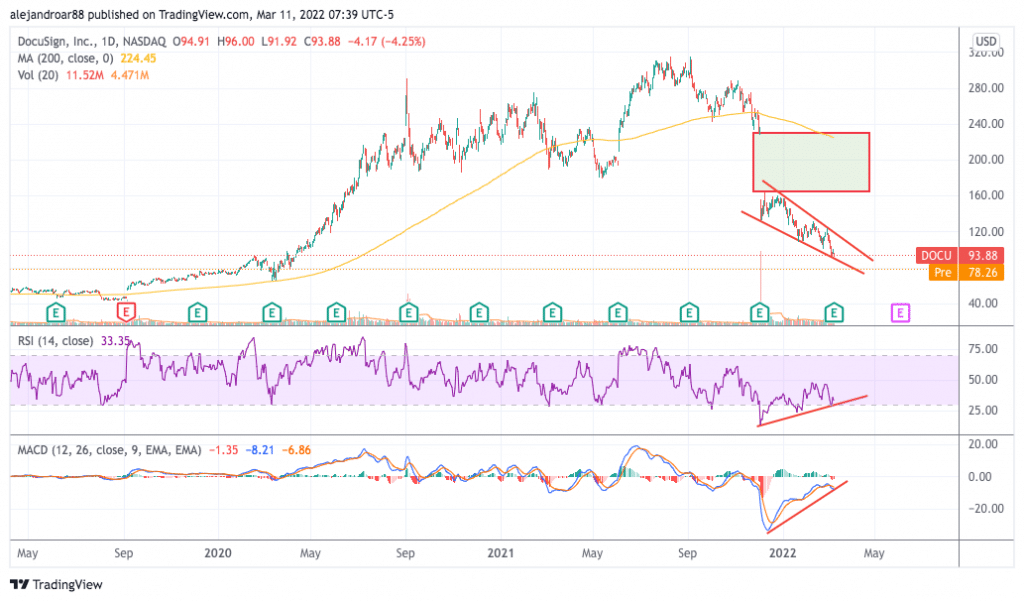DocuSign Stock Down 18% Today – Time to Buy DOCU Stock?
Please note that we are not authorised to provide any investment advice. The content on this page is for information purposes only.
The price of DocuSign stock is dropping 18% this morning in pre-market stock trading action following the release of the firm’s financial results covering the fourth quarter of its 2022 fiscal year as revenue guidance for next year lagged Wall Street’s consensus estimate for the period.
For the three months ended on 31 January, DocuSign reported total revenues of $580.8 million resulting in a 35% year-on-year jump. Subscription revenues accounted for most of the firm’s top-line results as they landed at $564 million, up 37% compared to a year ago. Analysts’ consensus estimate for the period stood at $561.6 million as per data from Capital IQ.
Total billings for the period jumped 37% at $670 million making this the fifth consecutive quarter of lower year-on-year growth for this non-GAAP metric. This quarter is also the second consecutive one in which the company has reported slower year-on-year revenue growth.
GAAP gross margins for DocuSign ended at 77% or 100 basis points higher than a year ago while non-GAAP gross margins experienced a 100 basis points increase as well at 81%
GAAP operating margins for the period stood at minus 4% resulting in a 200 basis points improvement compared to a year ago while non-GAAP operating margins ended the quarter at 18% or 100 basis points higher than the previous year.
Finally, GAAP losses per share ended the period at minus $0.15 on a fully diluted basis compared to minus $0.38 the firm reported the previous year while adjusted EPS increased 11 cents to $0.48 on a year-on-year basis. This adjusted figure was in line with analysts’ consensus estimate for the period.
For the first quarter and full 2023 fiscal year, DocuSign is forecasting revenues of up to $583 million and $2.48 billion respectively. The upper bound of both estimates came in well below Wall Street’s consensus estimate for the periods.
The fact that the company’s billings and revenues have been growing at a slower pace compared to previous periods is most likely the reason why DocuSign stock is dropping this morning.
What could be expected from this tech stock following the release of this quarterly report? In this article, we will be assessing the price action and fundamentals of DocuSign stock to outline plausible scenarios for the future.
67% of all retail investor accounts lose money when trading CFDs with this provider.
DocuSign Stock – Technical Analysis

The price of DOCU has declined 38.3% so far in 2022 as market sentiment toward stocks in the tech sector has shifted radically amid an expected change in macroeconomic conditions.
In this regard, US Treasury yields have climbed to their highest level since the pandemic started with the yield of 10-year US Treasury Notes currently sitting at 2% – just 6.5 basis points below their 52-week high.
DocuSign stock also experienced a sharp decline after the company’s previous quarterly report was released. Back then, the stock went down 42.2% in a single day and kept declining during the weeks that followed as revenue growth decelerated.
Today’s drop is pushing the price below the price channel indicated in the chart and that is a signal that the downtrend for DOCU could accelerate in the coming weeks.
That said, a relatively aggressive bullish divergence has popped up in both the Relative Strength Index (RSI) and the MACD and this could indicate that the downtrend may soon reach a short-term bottom.
For now, the outlook for DocuSign stock remains bearish and the next horizontal support to watch would be found at the $65 level. This results in a total downside risk of 31% based on yesterday’s closing price.
DocuSign Stock – Fundamental Analysis
DocuSign’s slower year-on-year revenue and billings growth rate is perhaps the most concerning factor at the moment and possibly what Wall Street analysts are watching more closely.
Since DOCU is considered a growth stock, the pace at which the firm’s top-line results advance is the most relevant variable that shapes its valuation.
Based on the firm’s guidance for the 2023 fiscal year, revenues should grow by 22% next year compared to a 49.2% jump reported by the firm in 2021 and a 47.5% jump reported during this 2022 fiscal year.
Why is the management guiding for lower historical revenue growth for this year?
Cyhthia Gaylor, DocuSign’s Chief Financial Officer, stated the following in regards to the firm’s revenue guidance for Q1 2023 during the earnings call that followed the release of this report:
“There’s probably two key drivers on revenue behind the guide. One is headwinds from some of the onetime use cases rolling off or renewing at lower levels. The second is just the timing of deals rolling into the quarter and deals rolling out of the quarter”.
In summary, she is saying that some customers who signed up for the service during the pandemic may not be finding it as useful as before now that millions of people have gone back to their physical offices.
This indicates that the pandemic-related tailwind that once lifted the business’s top-line performance has fully faded and that could have a negative impact on revenue growth down the road depending on how many of those customers end up shunning the service.
If today’s pre-market downtick spills over as is to the live session, DocuSign will be trading at around 6 times its forecasted sales for the period. Meanwhile, the company generated $445 million in free cash flows last year resulting in an FCF margin of 21.1%.
If we use that margin as a reference for the 2023 fiscal year, DocuSign could produce around $523 million in free cash flows this year resulting in a forward P/FCF ratio of 36.6x. considering the fact that the company more than doubled its free cash flows in a single year, this is not a stretched valuation multiple.
However, with growth stocks, cash-flow generation capacity tends to take the back seat as Wall Street is normally focused on growth rates. In any case, since the valuation seems to be fair or even attractive at current levels, chances are that the stock could soon hit bottom to then progressively recover depending on how the business performs in the future.






